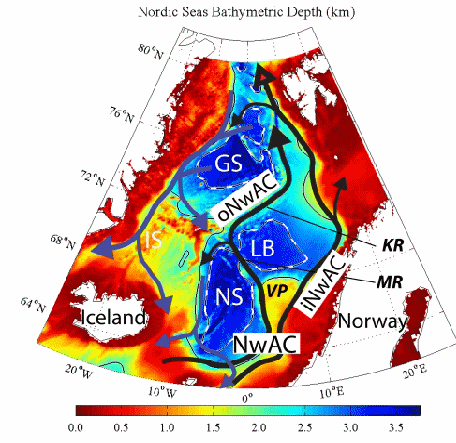|
|
Atlantic Water Transformation in the Nordic
Sea: The Lofoten Basin
PIs: Fiammetta Straneo (WHOI), Thomas Rossby
(URI), Jonathan Lilly (ESR), Mike Spall (WHOI)
The
traditionally central role played by the deep convective
regions of the North Atlantic—the Labrador Sea and the
Greenland Sea—in driving the Atlantic Meridional
Overturning Circulation (AMOC) and its associated poleward
heat transport has been severely questioned over the last
decade. In particular, it is now known that relatively little
sinking and only a limited surface buoyancy loss occurs in
these regions and, furthermore, that the dense water masses
feeding the AMOC are not a direct product of these regions. In
the case of the Nordic Seas, the Greenland-Scotland overflow
waters comprising the deepest branch of the AMOC contain only
small amounts of Greenland Sea Water, and are instead largely
the product of the progressive transformation of the
circulating warm, salty Atlantic Waters. Yet the pathways and
processes through which this transformation occurs are largely
unknown.
Emerging
as playing a central role in this transformation is the
Lofoten Basin, which sits adjacent to the Greenland Sea
between the two main branches of the Atlantic inflow. The
warm, salty Atlantic waters are strongly modified as they
transit through this basin, which alone accounts for a
substantial fraction of the surface buoyancy loss over the
Nordic Seas. This leads to the formation of an intermediate
convected product, the Lofoten Basin Mode Water. Unlike
Labrador Sea Water and Greenland Sea Water, the Lofoten Basin
Mode Water can be rapidly exported from the basin, and is a
direct source for the overflows waters. Despite its
importance, however, the basic dynamical features of this
basin and of its intermediate water mass formation have yet to
be addressed.
We
will conduct a combined observational and modeling study to
investigate mode water formation in the Lofoten Basin and its
eventual export. A profiling mooring together with RAFOS
floats deployed directly within the basin will clarify the
annual cycle of transformation, restratification, and
dispersal. Analysis of existing hydrographic, float, and
remote sensing data will help to guide the field work, and
will enable us to investigate larger-scale and longer-term
variability. A variety of models will be employed to study the
dynamics of the transformation process in the Lofoten Basin
and elsewhere in the Nordic Seas. The net result will be a new
understanding of the interaction between air-sea fluxes and
ocean dynamics along this crucial branch of the AMOC.
|

|
Figure:
Bathymetry and major geographic features of the Nordic Seas
(the 2000 m and 3000 m depth contours are indicated by thin
black and dashed lines). LB=Lofoten Basin; NS=Norwegian
Sea; GS=Greenland Sea; MR=Mohn Ridge; KR=Knipovich Ridge;
VP=Vøring Plateau. The warm Atlantic water pathways
of the NwAC and of its inner and outer branches are drawn
as black lines. The intermediate flow that feeds the
overflows is indicated schematically as blue lines. Both
redrawn from Hansen and Østerhus (2000).
|
 This
project is supported by the National Science Foundation Ocean
Sciences and Office of Polar Programs Divisions. This
project is supported by the National Science Foundation Ocean
Sciences and Office of Polar Programs Divisions.
|